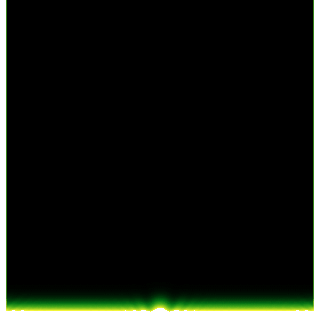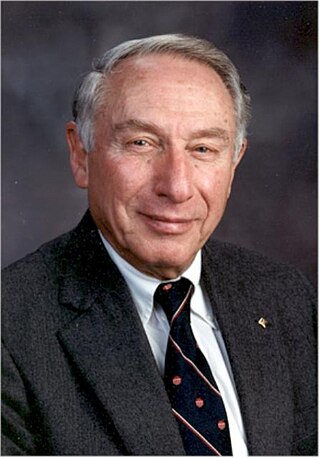Related Research Articles

Acoustics is a branch of physics that deals with the study of mechanical waves in gases, liquids, and solids including topics such as vibration, sound, ultrasound and infrasound. A scientist who works in the field of acoustics is an acoustician while someone working in the field of acoustics technology may be called an acoustical engineer. The application of acoustics is present in almost all aspects of modern society with the most obvious being the audio and noise control industries.
A pitch detection algorithm (PDA) is an algorithm designed to estimate the pitch or fundamental frequency of a quasiperiodic or oscillating signal, usually a digital recording of speech or a musical note or tone. This can be done in the time domain, the frequency domain, or both.
Gerhard M. Sessler is a German inventor and scientist. He is Professor emeritus at the Department of Electrical Engineering and Information Technology of the Technische Universität Darmstadt.
Acoustic holography is a method for estimating the sound field near a source by measuring acoustic parameters away from the source by means of an array of pressure and/or particle velocity transducers. The Measuring techniques included in acoustic holography are becoming increasingly popular in various fields, most notably those of transportation, vehicle and aircraft design, and noise, vibration, and harshness (NVH). The general idea of acoustic holography has led to different versions such as near-field acoustic holography (NAH) and statistically optimal near-field acoustic holography (SONAH).
Sound from ultrasound is the name given here to the generation of audible sound from modulated ultrasound without using an active receiver. This happens when the modulated ultrasound passes through a nonlinear medium which acts, intentionally or unintentionally, as a demodulator.
A parametric array, in the field of acoustics, is a nonlinear transduction mechanism that generates narrow, nearly side lobe-free beams of low frequency sound, through the mixing and interaction of high frequency sound waves, effectively overcoming the diffraction limit associated with linear acoustics. The main side lobe-free beam of low frequency sound is created as a result of nonlinear mixing of two high frequency sound beams at their difference frequency. Parametric arrays can be formed in water, air, and earth materials/rock.
Peter Westervelt was an American physicist, noted for his work in nonlinear acoustics, and Professor Emeritus of Physics at Brown University.

A Bessel beam is a wave whose amplitude is described by a Bessel function of the first kind. Electromagnetic, acoustic, gravitational, and matter waves can all be in the form of Bessel beams. A true Bessel beam is non-diffractive. This means that as it propagates, it does not diffract and spread out; this is in contrast to the usual behavior of light, which spreads out after being focused down to a small spot. Bessel beams are also self-healing, meaning that the beam can be partially obstructed at one point, but will re-form at a point further down the beam axis.
The ASA Silver Medal is an award presented by the Acoustical Society of America to individuals, without age limitation, for contributions to the advancement of science, engineering, or human welfare through the application of acoustic principles or through research accomplishments in acoustics. The medal is awarded in a number of categories depending on the technical committee responsible for making the nomination.

Floyd Dunn was an American electrical engineer who made contributions to all aspects of the interaction of ultrasound and biological media. Dr. Dunn was a member of Scientific Committee 66 of the National Council on Radiation Protection and Measurements as well as many FDA, NIH, AIUM, and ASA committees. He collaborated with scientists in the UK, Japan, China and Post-Soviet states.
An acousto-optical spectrometer (AOS) is based on the diffraction of light by ultrasonic waves. A piezoelectric transducer, driven by the RF signal, generates an acoustic wave in a crystal. This acoustic wave modulates the refractive index and induces a phase grating. The Bragg-cell is illuminated by a collimated laser beam. The angular dispersion of the diffracted light represents a true image of the IF-spectrum according to the amplitude and wavelengths of the acoustic waves in the crystal. The spectrum is detected by using a single linear diode array (CCD), which is placed in the focal plane of an imaging optics. Depending on the crystal and the focal length of the imaging optics, the resolution of this type of spectrometer can be varied.
Acoustic resonance spectroscopy (ARS) is a method of spectroscopy in the acoustic region, primarily the sonic and ultrasonic regions. ARS is typically much more rapid than HPLC and NIR. It is non destructive and requires no sample preparation as the sampling waveguide can simply be pushed into a sample powder/liquid or in contact with a solid sample. To date, the AR spectrometer has successfully differentiated and quantified sample analytes in various forms;. It has been used to measure and monitor the progression of chemical reactions, such as the setting and hardening of concrete from cement paste to solid. Acoustic spectrometry has also been used to measure the volume fraction of colloids in a dispersion medium, as well as for the investigation of physical properties of colloidal dispersions, such as aggregation and particle size distribution. Typically, these experiments are carried out with sinusoidal excitation signals and the experimental observation of signal attenuation. From a comparison of theoretical attenuation to experimental observation, the particle size distribution and aggregation phenomena are inferred.
Acoustic attenuation is a measure of the energy loss of sound propagation in media. Most media have viscosity and are therefore not ideal media. When sound propagates in such media, there is always thermal consumption of energy caused by viscosity. This effect can be quantified through the Stokes's law of sound attenuation. Sound attenuation may also be a result of heat conductivity in the media as has been shown by G. Kirchhoff in 1868. The Stokes-Kirchhoff attenuation formula takes into account both viscosity and thermal conductivity effects.
The acoustoelastic effect is how the sound velocities of an elastic material change if subjected to an initial static stress field. This is a non-linear effect of the constitutive relation between mechanical stress and finite strain in a material of continuous mass. In classical linear elasticity theory small deformations of most elastic materials can be described by a linear relation between the applied stress and the resulting strain. This relationship is commonly known as the generalised Hooke's law. The linear elastic theory involves second order elastic constants and yields constant longitudinal and shear sound velocities in an elastic material, not affected by an applied stress. The acoustoelastic effect on the other hand include higher order expansion of the constitutive relation between the applied stress and resulting strain, which yields longitudinal and shear sound velocities dependent of the stress state of the material. In the limit of an unstressed material the sound velocities of the linear elastic theory are reproduced.

Gordon Eugene Martin is an American physicist and author in the field of piezoelectric materials for underwater sound transducers. He wrote early computer software automating iterative evaluation of direct computer models through a Jacobian matrix of complex numbers. His software enabled the Navy Electronics Laboratory (NEL) to accelerate design of sonar arrays for tracking Soviet Navy submarines during the Cold War.

Harvey Berger was a scientist and inventor. He invented the modern commercial ultrasonic nozzle, which in its application has brought many benefits to the fields of research, combustion and manufacturing. Berger founded Sono-Tek Corporation based on this technology and while working at the company he made contributions to the fields of combustion, semiconductor manufacturing, electronic printed circuit board manufacturing, drug eluting stents and spray drying. Berger died in August 2007 after a struggle with liver cancer. He was survived by his wife Donna and by his three children, Michael, Robyn and Barbara.

Timothy Grant Leighton is the Professor of Ultrasonics and Underwater Acoustics at the University of Southampton. He is the inventor-in-chief of Sloan Water Technology Ltd., a company founded around his inventions. He is an academician of three national academies. Trained in physics and theoretical physics, he works across physical, medical, biological, social and ocean sciences, fluid dynamics and engineering. He joined the Institute of Sound and Vibration Research (ISVR) at the University of Southampton in 1992 as a lecturer in underwater acoustics, and completed the monograph The Acoustic Bubble in the same year. He was awarded a personal chair at the age of 35 and has authored over 400 publications.
The Pioneers of Underwater Acoustics Medal is awarded by the Acoustical Society of America in recognition of "an outstanding contribution to the science of underwater acoustics, as evidenced by publication of research results in professional journals or by other accomplishments in the field". The award was named in honor of H. J. W. Fay, Reginald Fessenden, Harvey Hayes, G. W. Pierce, and Paul Langevin.

Brian C.J. Moore FMedSci, FRS is an Emeritus Professor of Auditory Perception in the University of Cambridge and an Emeritus Fellow of Wolfson College, Cambridge. His research focuses on psychoacoustics, audiology, and the development and assessment of hearing aids.

Christian Lorenzi is Professor of Experimental Psychology at École Normale Supérieure in Paris, France, where he has been Director of the Department of Cognitive Studies and Director of Scientific Studies until. Lorenzi works on auditory perception.
References
- ↑ Digital Picture Processing, 2nd edition 1982, Azriel Rosenfeld, Avinash C. Kak, ISBN 0-12-597302-0, Academic Press, Inc.
- ↑ Linear Systems, Fourier Transforms, and Optics (Wiley Series in Pure and Applied Optics) Jack D. Gaskill
- ↑ Introduction to Fourier Optics, Joseph W. Goodman.
- ↑ Angular Spectrum Approach, Robert J. McGough
- ↑ Waag, R.C.; Campbell, J.A.; Ridder, J.; Mesdag, P.R. (1985). "Cross-Sectional Measurements and Extrapolations of Ultrasonic Fields". IEEE Transactions on Sonics and Ultrasonics. Institute of Electrical and Electronics Engineers (IEEE). 32 (1): 26–35. Bibcode:1985ITSU...32...26W. doi:10.1109/t-su.1985.31566. ISSN 0018-9537.
- ↑ Stepanishen, Peter R.; Benjamin, Kim C. (1982). "Forward and backward projection of acoustic fields using FFT methods". The Journal of the Acoustical Society of America. Acoustical Society of America (ASA). 71 (4): 803–812. Bibcode:1982ASAJ...71..803S. doi:10.1121/1.387606. ISSN 0001-4966.
- ↑ Vecchio, Christopher J.; Lewin, Peter A. (1994). "Finite amplitude acoustic propagation modeling using the extended angular spectrum method". The Journal of the Acoustical Society of America. Acoustical Society of America (ASA). 95 (5): 2399–2408. Bibcode:1994ASAJ...95.2399V. doi:10.1121/1.409849. ISSN 0001-4966.
- ↑ Vecchio, Chris; Lewin, Peter A. (1992). Acoustic propagation modeling using the extended angular spectrum method. 14th Annual International Conference of the IEEE Engineering in Medicine and Biology Society. IEEE. doi:10.1109/iembs.1992.5762211. ISBN 0-7803-0785-2.
- ↑ Christopher, P. Ted; Parker, Kevin J. (1991). "New approaches to nonlinear diffractive field propagation". The Journal of the Acoustical Society of America. Acoustical Society of America (ASA). 90 (1): 488–499. Bibcode:1991ASAJ...90..488C. doi:10.1121/1.401274. ISSN 0001-4966. PMID 1880298.
- ↑ Zemp, Roger J.; Tavakkoli, Jahangir; Cobbold, Richard S. C. (2003). "Modeling of nonlinear ultrasound propagation in tissue from array transducers". The Journal of the Acoustical Society of America. Acoustical Society of America (ASA). 113 (1): 139–152. Bibcode:2003ASAJ..113..139Z. doi:10.1121/1.1528926. ISSN 0001-4966. PMID 12558254.
- ↑ Vecchio, Christopher John (1992). Finite Amplitude Acoustic Propagation Modeling Using the Extended Angular Spectrum Method (PhD). Dissertation Abstracts International. Bibcode:1992PhDT........59V.
- ↑ Schafer, Mark E.; Lewin, Peter A. (1989). "Transducer characterization using the angular spectrum method". The Journal of the Acoustical Society of America. Acoustical Society of America (ASA). 85 (5): 2202–2214. Bibcode:1989ASAJ...85.2202S. doi: 10.1121/1.397869 . ISSN 0001-4966.
- ↑ Vecchio, Christopher J.; Schafer, Mark E.; Lewin, Peter A. (1994). "Prediction of ultrasonic field propagation through layered media using the extended angular spectrum method". Ultrasound in Medicine & Biology. Elsevier BV. 20 (7): 611–622. doi:10.1016/0301-5629(94)90109-0. ISSN 0301-5629. PMID 7810021.